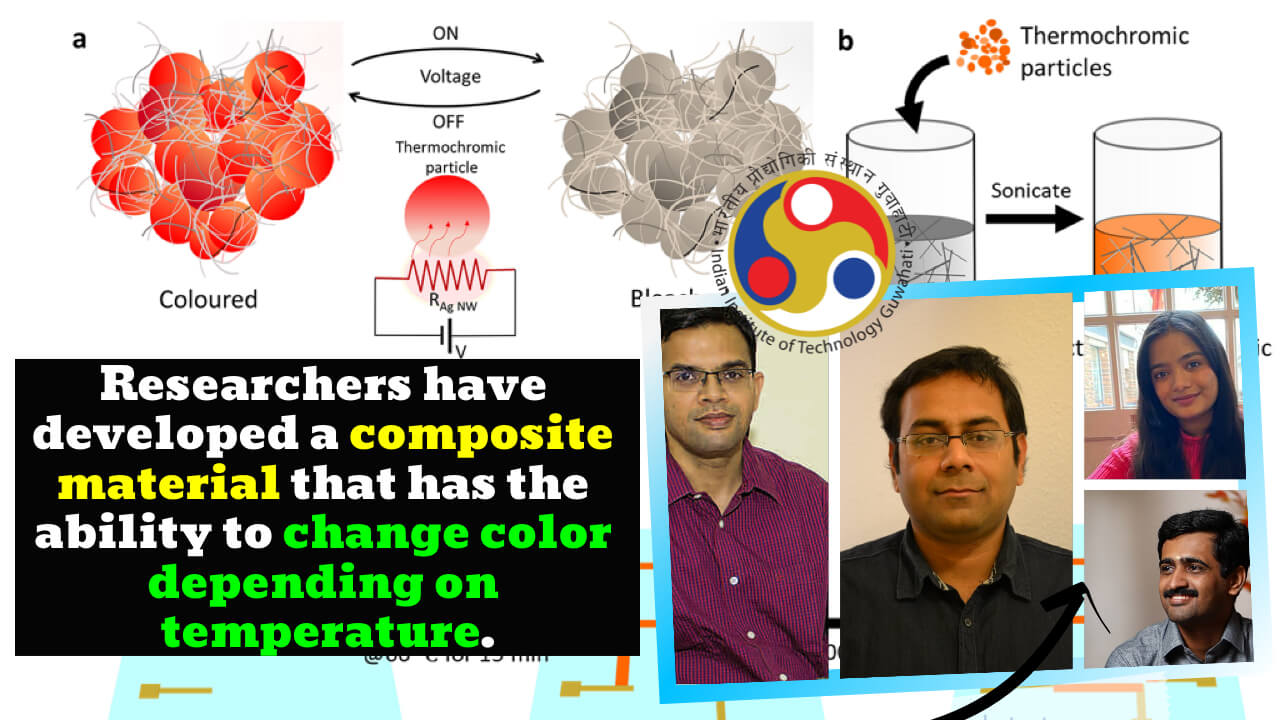Low-cost, flexible, light-weight, and energy-efficient displays are being developed. An electrochromic display is a better choice for low-cost displays. Inflexibility and high processing temperatures are disadvantages of electrochromism.
A nanowire and thermochromic ink can show multiple colors. This can be used in flexible screens, posters, smart labels, and display boards. The display device can also be used as a touch sensor, working in dual mode.
Key Highlight:
- IIT Madras Researchers have created an electrothermochromic composite material with silver nanowires (Ag NWs) and thermochromic powders that changes color (phase) when heated by Joule.
- The composite’s low processing temperature of 100°C makes it compatible with flexible substrates like paper and PET (PET).
- The material (encapsulated in PDMS) is flexible and functional after 10,000 bending cycles with a 7% resistance change.
- Researchers also showed that the same layer could act as a display and a touch sensor due to its conducting and chromatic properties.
- Fabrication of low-cost, flexible touch color displays for interactive electronic readers, digital posters and signboards.
- Nano-electronic displays are flexible, cost-effective, and easy to make. They could be used to make smart labels.
Flexible displays that change colors based on temperature are a new area of research. Researchers developed a new material made of silver wires and heat-sensitive powder. These displays change colors when you apply an electrical current.
The researchers have developed a flexible, low cost and power-effective electronic display. They plan to extend the results into smart labels with and without sensing capability.
Displays are an important part of today’s electronic devices. There is a lot of effort to make more inexpensive, flexible, lightweight displays and don’t use a lot of power. Liquid crystal displays, organic light-emitting diodes (OLEDs), and quantum dot displays are some of the displays already out there. These displays, although they may seem perfect, have some problems.
For cheap displays, electrochromic (EC) displays are a better choice. When the switching-frequency requirements for applications are low, EC displays are better. Some people don’t like the idea of using electrochromism at all. Electrochromic devices aren’t very flexible, so they need to be processed at high temperatures for these kinds of jobs. Making the displays takes a lot of time and money, and there are a lot of layers that need to be put together.
It is a new way to make things, and the people who did this study used it to deal with these problems. Printing is an example of this.
Silver nanowires and a thermochromic polymer make the electrothermochromic material as a dispersion that can be printed. Silver is used because it has good conductivity, ductility, and flexibility so that it can be used in a lot of different ways. If you apply a lot of electricity, the silver nanowires will get heated up by joule heating. This will make the thermochromic material in the composite change color. Conventional electronic displays are made up of many layers. For the first time, a composite (a composite is when a lot of different materials are mixed together into one layer) was made. It had the heating and thermochromic layers in the same layer instead of separate layers. Electricity and chromism properties are found in the same layer.
Polydimethylsiloxane (PDMS), a clear dielectric, was used to protect the display layer. To make the touch-sensitive part of the screen, silver nanowires were encased in PDMS.
When this was done, a single-layer electrothermochromic composite with silver nanowires was made. It can be used to make things that change color when heated or cooled (by selecting suitable thermochromic material). Also important is the display of ink that can be printed. This can be used in interactive and flexible screens, electronic posters, smart labels, and display boards. It can also be used in smart labels and smart tags. In this composite, the display and touch are all on the same layer, which isn’t the case with normal screens. The display is flexible, cheap, and doesn’t use much power. The people who did this study want to apply their findings to smart labels that can sense things and those that can’t. Humidity sensors can be used in smart labels to figure out how long a product has been around and change the display accordingly. Because these displays are cheap and easy to make, they could be very useful in the future.
Dipti Gupta, a professor at the Indian Institute of Technology Bombay in Mumbai, shows that flexible displays can be made by using the phenomenon of electro-thermochromism, which allows the material to change color when it is heated by Joules. This work is important because it shows that this phenomenon can make flexible displays. Researchers have come up with an ink that can be rolled out, put on a flexible substrate in any pattern you want, and be annealed at low temperatures, making it good for many different flexible substrates. After it is encased in polydimethylsiloxane (PDMS), the low-power device has good electro-mechanical performance and can be used again and again. The display device can also be used as a touch sensor simultaneously, making it useful for a wide range of applications, such as electronic readers, digital posters, flexible digital signs, and more.
Original Paper- https://pubs.acs.org/doi/10.1021/acsami.1c09115
#TechTuesday
— IIT Madras (@iitmadras) January 18, 2022
Researchers, including those from @iitmadras, develop silver nanowire-based printable electrothermochromic composite ink for flexible touch-display applications.https://t.co/dVPtyxqe4ihttps://t.co/F1IL2CTzDi
(1/2) pic.twitter.com/39SmyVSI4y





[…] Researchers have developed a composite material that can change color depending… […]